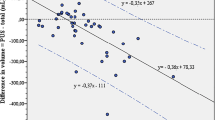Abstract
The objective of this prospective study was to evaluate the accuracy of conventional 2D ultrasound (CUS) versus doppler planimetry (DP) in the assessment of postpartum urinary bladder volume compared to a true estimate using urethral catheterisation. Fifty-two women were assessed within 24 hours of delivery. Evaluation of bladder volume was performed using CUS (1-estimate) and DP (6-estimates). CUS had a higher correlation (r=0.796) with the true volume and lower % error than DP in the postpartum group. DP readings were highly reproducible (ICC 0.81) but tended to overestimate the true value especially with smaller volumes. DP was suboptimal for the assessment of the postpartum PVR. Postpartum evaluation using CUS is more accurate in calculating the true urinary volume.
Similar content being viewed by others
References
Harrison NW, Parks C, Sherwood T (1975) Ultrasound assessment of residual urine in children. Br J Urol 47:805–814
Cardenas DD, Kelly E, Krieger JN, Chapman WH (1988) Residual urine volumes in patients with spinal cord injury: measurement with a portable ultrasound instrument. Arch Phys Med Rehabil 69:514–516
Topper AK, Holliday PJ, Fernie GR (1993) Bladder volume estimation in the elderly using a portable ultrasound-based measurement device. J Med Eng Technol 17:99–103
Ireton RC, Krieger JN, Cardenas DD, Williams-Burden B, Kelly E, Souci T, Chapman WH (1990) Bladder volume determination using a dedicated, portable ultrasound scanner. J Urol 143:909–911
Ding YY, Sahadevan S, Pang WS, Choo PW (1996) Clinical utility of a portable ultrasound scanner in the measurement of residual urine volume. Singapore Med J 37:365–368
Barrington JW, Jones A, Robinson J, Stephenson TP (1996) Estimation of bladder volume using portable ultrasound in clam enterocystoplasty patients. J Urol 155:82–83
Barrington JW, Bowen-Simpkins P (1996) A comparison between portable ultrasound and urethral catheterisation in the measurement of female bladder volume. J Obstet Gynaecol 16:50–51
Bent AE, Nahhas DE, McLennan MT (1997) Portable ultrasound determination of urinary residual volume. Int Urogynecol J Pelvic Floor Dysfunct 8:200–202
Revord JP, Opitz JL, Murtaugh P, Harrison J (1993) Determining residual urine volumes using a portable ultrasonographic device. Arch Phys Med Rehabil 74:457–462
Alnaif B, Drutz HP (1999) The accuracy of portable abdominal ultrasound equipment in measuring postvoid residual volume. Int Urogynecol J Pelvic Floor Dysfunct 10:215–218
Barrington JW, Edwards G, Ashcroft M, Adekanmi O (2001) Measurement of bladder volume following cesarean section using Bladderscan. Int Urogynecol J Pelvic Floor Dysfunct 12:373–374
Pallis LM, Wilson M (2003) Ultrasound assessment of bladder volume: is it valid after delivery? Aust N Z J Obstet Gynaecol 43:453–456
Demaria F, Amar N, Biau D, Fritel X, Porcher R, Amarenco G, Madelenat P, Benifla JL (2004) Prospective 3D ultrasonographic evaluation of immediate postpartum urine retention volume in 100 women who delivered vaginally. Int Urogynecol J Pelvic Floor Dysfunct 15:281–285
Ramsay IN, Torbet TE (1993) Incidence of abnormal voiding parameters in the immediate postpartum period. Neurourol Urodyn 12:179–183
Weil A, Reyes H, Rottenberg RD, Beguin F, Herrmann WL (1983) Effect of lumbar epidural analgesia on lower urinary tract function in the immediate postpartum period. Br J Obstet Gynaecol 90:428–432
Carley ME, Carley JM, Vasdev G, Lesnick TG, Webb MJ, Ramin KD, Lee RA (2002) Factors that are associated with clinically overt postpartum urinary retention after vaginal delivery. Am J Obstet Gynecol 187:430–433
Saultz JW, Toffler WL, Shackles JY (1991) Postpartum urinary retention. J Am Board Fam Pract 4:341–344
Yip SK, Brieger G, Hin LY, Chung T (1997) Urinary retention in the post-partum period. The relationship between obstetric factors and the post-partum post-void residual bladder volume. Acta Obstet Gynecol Scand 76:667–672
Lee SN, Lee CP, Tang OS, Wong WM (1999) Postpartum urinary retention. Int J Gynaecol Obstet 66:287–288
Byun SS, Kim HH, Lee E, Paick JS, Kamg W, Oh SJ (2003) Accuracy of bladder volume determinations by ultrasonography: are they accurate over entire bladder volume range? Urology 62:656–660
Goode PS, Locher JL, Bryant RL, Roth DL, Burgio KL (2000) Measurement of postvoid residual urine with portable transabdominal bladder ultrasound scanner and urethral catheterization. Int Urogynecol J Pelvic Floor Dysfunct 11:296–300
Haylen BT, Frazer MI, MacDonald JH (1989) Assessing the effectiveness of different urinary catheters in emptying the bladder: an application of transvaginal ultrasound. Br J Urol 64:353–356
Yip SK, Sahota D, Chang AM (2003) Determining the reliability of ultrasound measurements and the validity of the formulae for ultrasound estimation of postvoid residual bladder volume in postpartum women. Neurourol Urodyn 22:255–260
Acknowledgement
We would like to thank Mrs. Patricia Swaby (Urodynamic Nurse Specialist) for undertaking the Bladder Scan measurements in the group of women attending urodynamic testing.
Conflicts of interest
None.
Author information
Authors and Affiliations
Corresponding author
Rights and permissions
About this article
Cite this article
Lee, J.W.S., Doumouchtsis, S.K. & Fynes, M.M. Is Doppler planimetry a valid technique for the evaluation of postpartum urinary bladder volume?. Int Urogynecol J 19, 1019–1025 (2008). https://doi.org/10.1007/s00192-007-0552-0
Received:
Accepted:
Published:
Issue Date:
DOI: https://doi.org/10.1007/s00192-007-0552-0




